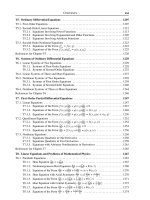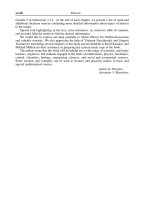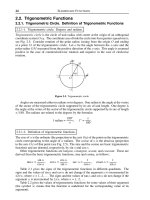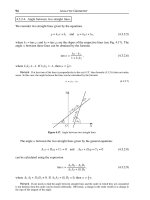Handbook of mathematics for engineers and scienteists part 179 pot
Bạn đang xem bản rút gọn của tài liệu. Xem và tải ngay bản đầy đủ của tài liệu tại đây (414.77 KB, 7 trang )
1214 ORDINARY DIFFERENTIAL EQUATIONS
5. y
xx
+ (ax + b)y
x
+ (αx
2
+ βx + γ)y =0.
The substitution y = uexp(sx
2
), where s is a root of the quadratic equation 4s
2
+2as+α =0,
leads to an equation of the form T5.2.1.11: u
xx
+[(a+4s)x+b]u
x
+[(β+2bs)x+γ +2s]u = 0.
6. xy
xx
+ ay
x
+ by =0.
1
◦
. The solution is expressed in terms of Bessel functions and modified Bessel functions:
y =
⎧
⎨
⎩
x
1–a
2
C
1
J
ν
2
√
bx
+ C
2
Y
ν
2
√
bx
if bx > 0,
x
1–a
2
C
1
I
ν
2
√
|bx|
+ C
2
K
ν
2
√
|bx|
if bx < 0,
where ν = |1 – a|.
2
◦
.Fora =
1
2
(2n + 1), where n = 0, 1, , the solution is
y =
⎧
⎪
⎨
⎪
⎩
C
1
d
n
dx
n
cos
√
4bx + C
2
d
n
dx
n
sin
√
4bx if bx > 0,
C
1
d
n
dx
n
cosh
4|bx| + C
2
d
n
dx
n
sinh
4|bx| if bx < 0.
7. xy
xx
+ ay
x
+ bxy =0.
1
◦
. The solution is expressed in terms of Bessel functions and modified Bessel functions:
y =
⎧
⎨
⎩
x
1–a
2
C
1
J
ν
√
bx
+ C
2
Y
ν
√
bx
if b > 0,
x
1–a
2
C
1
I
ν
√
|b| x
+ C
2
K
ν
√
|b| x
if b < 0,
where ν =
1
2
|1 – a|.
2
◦
.Fora = 2n,wheren = 1, 2, , the solution is
y =
⎧
⎪
⎨
⎪
⎩
C
1
1
x
d
dx
n
cos
x
√
b
+ C
2
1
x
d
dx
n
sin
x
√
b
if b > 0,
C
1
1
x
d
dx
n
cosh
x
√
–b
+ C
2
1
x
d
dx
n
sinh
x
√
–b
if b < 0.
8. xy
xx
+ ny
x
+ bx
1–2n
y =0.
For n = 1, this is the Euler equation T5.2.1.12. For n ≠ 1, the solution is
y =
⎧
⎪
⎪
⎪
⎨
⎪
⎪
⎪
⎩
C
1
sin
√
b
n – 1
x
1–n
+ C
2
cos
√
b
n – 1
x
1–n
if b > 0,
C
1
exp
√
–b
n – 1
x
1–n
+ C
2
exp
–
√
–b
n – 1
x
1–n
if b < 0.
9. xy
xx
+ ay
x
+ bx
n
y =0.
If n =–1 and b = 0, we have the Euler equation T5.2.1.12. If n ≠ –1 and b ≠ 0, the solution
is expressed in terms of Bessel functions:
y = x
1–a
2
C
1
J
ν
2
√
b
n + 1
x
n+1
2
+ C
2
Y
ν
2
√
b
n + 1
x
n+1
2
,whereν =
|1 – a|
n + 1
.
T5.2. SECOND-ORDER LINEAR EQUATIONS 1215
10. xy
xx
+ (b – x)y
x
– ay =0.
Degenerate hypergeometric equation.
1
◦
.Ifb ≠ 0,–1,–2,–3, , Kummer’s series is a particular solution:
Φ(a, b; x)=1 +
∞
k=1
(a)
k
(b)
k
x
k
k!
,
where (a)
k
= a(a + 1) (a + k – 1), (a)
0
= 1.Ifb > a > 0, this solution can be written in
terms of a definite integral:
Φ(a, b; x)=
Γ(b)
Γ(a) Γ(b – a)
1
0
e
xt
t
a–1
(1 – t)
b–a–1
dt,
where Γ(z)=
∞
0
e
–t
t
z–1
dt is the gamma function.
If b is not an integer, then the general solution has the form:
y = C
1
Φ(a, b; x)+C
2
x
1–b
Φ(a – b + 1, 2 – b; x).
2
◦
.Forb≠ 0,–1,–2,–3, , the general solution of the degenerate hypergeometric equation
can be written in the form
y = C
1
Φ(a, b; x)+C
2
Ψ(a, b; x),
while for b = 0,–1,–2,–3, , it can be represented as
y = x
1–b
C
1
Φ(a – b + 1, 2 – b; x)+C
2
Ψ(a – b + 1, 2 – b; x)
.
The functions Φ(a, b; x)andΨ(a, b; x) are described in Subsection 18.9 in detail.
11. (a
2
x + b
2
)y
xx
+ (a
1
x + b
1
)y
x
+ (a
0
x + b
0
)y =0.
Let the function J(a, b; x) be an arbitrary solution of the degenerate hypergeometric equa-
tion xy
xx
+(b – x)y
x
– ay = 0 (see T5.2.1.10), and let the function Z
ν
(x) be an arbitrary
solution of the Bessel equation x
2
y
xx
+ xy
x
+(x
2
– ν
2
)y = 0 (see T5.2.1.13). The results
of solving the original equation are presented in Table T5.1.
TABLE T5.1
Solutions of equation T5.2.1.11 for different values of the determining parameters
Solution: y = e
kx
w(z), where z =
x –μ
λ
Constraints
k λ
μ
w
Parameters
a
2
≠ 0,
a
2
1
≠ 4a
0
a
2
√
D –a
1
2a
2
–
a
2
2a
2
k +a
1
–
b
2
a
2
J(a, b; z)
a = B(k)/(2a
2
k +a
1
),
b =(a
2
b
1
–a
1
b
2
)a
–2
2
a
2
= 0,
a
1
≠ 0
–
a
0
a
1
1
–
2b
2
k +b
1
a
1
J
a,
1
2
; βz
2
a = B(k)/(2a
1
),
β =–a
1
/(2b
2
)
a
2
≠ 0,
a
2
1
= 4a
0
a
2
–
a
1
2a
2
a
2
–
b
2
a
2
z
ν/2
Z
ν
β
√
z
ν = 1 –(2b
2
k +b
1
)a
–1
2
,
β = 2
B(k)
a
2
= a
1
= 0,
a
0
≠ 0
–
b
1
2b
2
1
b
2
1
–4b
0
b
2
4a
0
b
2
z
1/2
Z
1/3
βz
3/2
;
see also 2.1.2.12
β =
2
3
a
0
b
2
1/2
Notation: D = a
2
1
–4a
0
a
2
, B(k)=b
2
k
2
+b
1
k +b
0
1216 ORDINARY DIFFERENTIAL EQUATIONS
12. x
2
y
xx
+ axy
x
+ by =0.
Euler equation. Solution:
y =
⎧
⎪
⎪
⎪
⎨
⎪
⎪
⎪
⎩
|x|
1–a
2
C
1
|x|
μ
+ C
2
|x|
–μ
if (1 – a)
2
> 4b,
|x|
1–a
2
(C
1
+ C
2
ln |x|)if(1 – a)
2
= 4b,
|x|
1–a
2
C
1
sin(μ ln |x|)+C
2
cos(μ ln |x|)
if (1 – a)
2
< 4b,
where μ =
1
2
|(1 – a)
2
– 4b|
1/2
.
13. x
2
y
xx
+ xy
x
+ (x
2
– ν
2
)y =0.
Bessel equation.
1
◦
.Letν be an arbitrary noninteger. Then the general solution is given by
y = C
1
J
ν
(x)+C
2
Y
ν
(x), (1)
where J
ν
(x)andY
ν
(x) are the Bessel functions of the first and second kind:
J
ν
(x)=
∞
k=0
(–1)
k
(x/2)
ν+2k
k! Γ(ν + k + 1)
, Y
ν
(x)=
J
ν
(x)cosπν – J
–ν
(x)
sin πν
.(2)
Solution (1) is denoted by y = Z
ν
(x), which is referred to as the cylindrical function.
The functions J
ν
(x)andY
ν
(x) can be expressed in terms of definite integrals (with
x > 0):
πJ
ν
(x)=
π
0
cos(x sin θ – νθ)dθ –sinπν
∞
0
exp(–x sinh t – νt) dt,
πY
ν
(x)=
π
0
sin(x sin θ – νθ) dθ –
∞
0
(e
νt
+ e
–νt
cos πν)e
–x sinh t
dt.
2
◦
. In the case ν = n +
1
2
,wheren = 0,1,2, , the Bessel functions are expressed in terms
of elementary functions:
J
n+
1
2
(x)=
2
π
x
n+
1
2
–
1
x
d
dx
n
sin x
x
, J
–n–
1
2
(x)=
2
π
x
n+
1
2
1
x
d
dx
n
cos x
x
,
Y
n+
1
2
(x)=(–1)
n+1
J
–n–
1
2
(x).
The Bessel functions are described in Section 18.6 in detail.
14. x
2
y
xx
+ xy
x
– (x
2
+ ν
2
)y =0.
Modified Bessel equation. It can be reduced to equation T5.2.1.13 by means of the substi-
tution x = i¯x (i
2
=–1).
Solution:
y = C
1
I
ν
(x)+C
2
K
ν
(x),
where I
ν
(x)andK
ν
(x) are modified Bessel functions of the first and second kind:
I
ν
(x)=
∞
k=0
(x/2)
2k+ν
k! Γ(ν + k + 1)
, K
ν
(x)=
π
2
I
–ν
(x)–I
ν
(x)
sin πν
.
The modified Bessel functions are described in Subsection 18.7 in detail.
T5.2. SECOND-ORDER LINEAR EQUATIONS 1217
15. x
2
y
xx
+ axy
x
+ (bx
n
+ c)y =0, n ≠ 0.
The case b = 0 corresponds to the Euler equation T5.2.1.12.
For b ≠ 0, the solution is
y = x
1–a
2
C
1
J
ν
2
n
√
bx
n
2
+ C
2
Y
ν
2
n
√
bx
n
2
,
where ν =
1
n
(1 – a)
2
– 4c; J
ν
(z)and Y
ν
(z) are the Bessel functions of the first and
second kind.
16. x
2
y
xx
+ axy
x
+ x
n
(bx
n
+ c)y =0.
The substitution ξ = x
n
leads to an equation of the form T5.2.1.11:
n
2
ξy
ξξ
+ n(n – 1 + a)y
ξ
+(bξ + c)y = 0.
17. x
2
y
xx
+ (ax + b)y
x
+ cy =0.
The transformation x = z
–1
, y = z
k
e
z
w,wherek is a root of the quadratic equation
k
2
+(1 – a)k + c = 0, leads to an equation of the form T5.2.1.11:
zw
zz
+[(2 – b)z + 2k + 2 – a]w
z
+[(1 – b)z + 2k + 2 – a – bk]w = 0.
18. (1–x
2
)y
xx
–2xy
x
+ n(n +1)y =0, n =0, 1, 2,
Legendre equation.
The solution is given by
y = C
1
P
n
(x)+C
2
Q
n
(x),
where the Legendre polynomials P
n
(x) and the Legendre functions of the second kind
Q
n
(x) are given by the formulas
P
n
(x)=
1
n! 2
n
d
n
dx
n
(x
2
– 1)
n
, Q
n
(x)=
1
2
P
n
(x)ln
1 + x
1 – x
–
n
m=1
1
m
P
m–1
(x)P
n–m
(x).
The functions P
n
= P
n
(x) can be conveniently calculated using the recurrence relations
P
0
(x)=1, P
1
(x)=x, P
2
(x)=
1
2
(3x
2
–1), , P
n+1
(x)=
2n+1
n+1
xP
n
(x)–
n
n+1
P
n–1
(x).
Three leading functions Q
n
= Q
n
(x)are
Q
0
(x)=
1
2
ln
1 + x
1 – x
, Q
1
(x)=
x
2
ln
1 + x
1 – x
– 1, Q
2
(x)=
3x
2
– 1
4
ln
1 + x
1 – x
–
3
2
x.
The Legendre polynomials and the Legendre functions are described in Subsection
18.11.1 in more detail.
1218 ORDINARY DIFFERENTIAL EQUATIONS
19. (1–x
2
)y
xx
–2xy
x
+ ν(ν +1)y =0.
Legendre equation; ν is an arbitrary number. The case ν = n where n is a nonnegative
integer is considered in T5.2.1.18.
The substitution z = x
2
leads to the hypergeometric equation. Therefore, with |x| < 1
the solution can be written as
y = C
1
F
–
ν
2
,
1 + ν
2
,
1
2
; x
+ C
2
xF
1 – ν
2
, 1 +
ν
2
,
3
2
; x
,
where F (α, β, γ; x) is the hypergeometric series (see T5.2.1.22).
The Legendre equation is discussed in Subsection 18.11.3 in more detail.
20. (ax
2
+ b)y
xx
+ axy
x
+ cy =0.
The substitution z =
dx
√
ax
2
+ b
leads to aconstant coefficient linear equation: y
zz
+cy =0.
21. (1–x
2
)y
xx
+ (ax + b)y
x
+ cy =0.
1
◦
. The substitution 2z = 1 + x leads to the hypergeometric equation T5.2.1.22:
z(1 – z)y
zz
+[az +
1
2
(b – a)]y
z
+ cy = 0.
2
◦
.Fora =–2m–3, b = 0,andc = λ, the Gegenbauer functions are solutions of the equation.
22. x(x –1)y
xx
+ [(α + β +1)x – γ]y
x
+ αβy =0.
Gaussian hypergeometric equation. For γ ≠ 0,–1,–2,–3, , a solution can be expressed
in terms of the hypergeometric series:
F (α, β, γ; x)=1 +
∞
k=1
(α)
k
(β)
k
(γ)
k
x
k
k!
,(α)
k
= α(α + 1) (α + k – 1),
which, a fortiori, is convergent for |x| < 1.
For γ > β > 0, this solution can be expressed in terms of a definite integral:
F (α, β, γ; x)=
Γ(γ)
Γ(β) Γ(γ – β)
1
0
t
β–1
(1 – t)
γ–β–1
(1 – tx)
–α
dt,
where Γ(β) is the gamma function.
If γ is not an integer, the general solution of the hypergeometric equation has the form:
y = C
1
F (α, β, γ; x)+C
2
x
1–γ
F (α – γ + 1, β – γ + 1, 2 – γ; x).
In the degenerate cases γ =0,–1,–2,–3, , a particularsolution of the hypergeometric
equation corresponds to C
1
= 0 and C
2
= 1.Ifγ is a positive integer, another particular
solution corresponds to C
1
= 1 and C
2
= 0. In both these cases, the general solution can be
constructed by means of formula (2) given in the preliminary remarks at the beginning of
Section T5.2.
Table T5.2 gives the general solutions of the hypergeometric equation for some values
of the determining parameters.
The hypergeometric functions F (α, β, γ; x) are discussed in Section 18.10 in detail.
T5.2. SECOND-ORDER LINEAR EQUATIONS 1219
TABLE T5.2
General solutions of the hypergeometric equation for some values of the determining parameters
α
β
γ
Solution: y = y(x)
0
β
γ
C
1
+C
2
|x|
–γ
|x –1|
γ–β–1
dx
α
α+
1
2
2α+ 1 C
1
1 +
√
1 –x
–2α
+C
2
x
–2α
1 +
√
1 –x
2α
α
α–
1
2
1
2
C
1
1 +
√
x
1–2α
+C
2
1 –
√
x
1–2α
α
α+
1
2
3
2
1
√
x
C
1
1 +
√
x
1–2α
+C
2
1 –
√
x
1–2α
1
β
γ
|x|
1–γ
|x –1|
γ–β–1
C
1
+C
2
|x|
γ–2
|x –1|
β–γ
dx
α
β
α
|x –1|
–β
C
1
+C
2
|x|
–α
|x –1|
β–1
dx
α
β
α+1
|x|
–α
C
1
+C
2
|x|
α–1
|x –1|
–β
dx
23. (1–x
2
)
2
y
xx
–2x(1–x
2
)y
x
+ [ν(ν +1)(1–x
2
) – μ
2
]y =0.
Legendre equation, ν and μ are arbitrary parameters.
The transformation x = 1 – 2ξ, y = |x
2
– 1|
μ/2
w leads to the hypergeometric equation
T5.2.1.22:
ξ(ξ – 1)w
ξξ
+(μ + 1)(1 – 2ξ)w
ξ
+(ν – μ)(ν + μ + 1)w = 0
with parameters α = μ – ν, β = μ + ν + 1, γ = μ + 1.
In particular, the original equation is integrable by quadrature if ν = μ or ν =–μ – 1.
24. (x – a)
2
(x – b)
2
y
xx
– cy =0, a ≠ b.
The transformation ξ =ln
x – a
x – b
, y =(x–b)η leads to a constant coefficient linear equation:
(a – b)
2
(η
ξξ
– η
ξ
)–cη = 0. Therefore, the solution is as follows:
y = C
1
|x – a|
(1+λ)/2
|x – b|
(1–λ)/2
+ C
2
|x – a|
(1–λ)/2
|x – b|
(1+λ)/2
,
where λ
2
= 4c(a – b)
–2
+ 1 ≠ 0.
25. (ax
2
+ bx + c)
2
y
xx
+ Ay =0.
The transformation ξ =
dx
ax
2
+ bx + c
, w =
y
|ax
2
+ bx + c|
leads to aconstant coefficient
linear equation of the form T5.2.1.1: w
ξξ
+(A + ac –
1
4
b
2
)w = 0.
26. x
2
(ax
n
–1)y
xx
+ x(apx
n
+ q)y
x
+ (arx
n
+ s)y =0.
Find the roots A
1
, A
2
and B
1
, B
2
of the quadratic equations
A
2
–(q + 1)A – s = 0, B
2
–(p – 1)B + r = 0
1220 ORDINARY DIFFERENTIAL EQUATIONS
and define parameters c, α, β,andγ by the relations
c = A
1
, α =(A
1
+ B
1
)n
–1
, β =(A
1
+ B
2
)n
–1
, γ = 1 +(A
1
– A
2
)n
–1
.
Then the solution of the original equation has the form y = x
c
u(ax
n
), where u = u(z)isthe
general solution of the hypergeometric equation T5.2.1.22: z(z–1)u
zz
+[(α+β+1)z–γ]u
z
+
αβu = 0.
T5.2.2. Equations Involving Exponential and Other Functions
1. y
xx
+ ae
λx
y =0, λ ≠ 0.
Solution: y = C
1
J
0
(z)+C
2
Y
0
(z), where z = 2λ
–1
√
ae
λx/2
; J
0
(z)andY
0
(z) are Bessel
functions.
2. y
xx
+ (ae
x
– b)y =0.
Solution: y = C
1
J
2
√
b
2
√
ae
x/2
+ C
2
Y
2
√
b
2
√
ae
x/2
,whereJ
ν
(z)andY
ν
(z) are Bessel
functions.
3. y
xx
– (ae
2λx
+ be
λx
+ c)y =0.
The transformation z = e
λx
, w = z
–k
y,wherek =
√
c/λ, leads to an equation of the form
T5.2.1.11: λ
2
zw
zz
+ λ
2
(2k + 1)w
z
–(az + b)w = 0.
4. y
xx
+ ay
x
+ be
2ax
y =0.
The transformation ξ = e
ax
, u = ye
ax
leads to a constant coefficient linear equation of the
form T5.2.1.1: u
ξξ
+ ba
–2
u = 0.
5. y
xx
– ay
x
+ be
2ax
y =0.
The substitution ξ = e
ax
leads to a constant coefficient linear equation of the form T5.2.1.1:
y
ξξ
+ ba
–2
y = 0.
6. y
xx
+ ay
x
+ (be
λx
+ c)y =0.
Solution: y =e
–ax/2
C
1
J
ν
2λ
–1
√
be
λx/2
+C
2
Y
ν
2λ
–1
√
be
λx/2
,whereν =
1
λ
√
a
2
– 4c;
J
ν
(z)andY
ν
(z) are Bessel functions.
7. y
xx
– (a –2q cosh 2x)y =0.
Modified Mathieu equation. The substitution x = iξ leads to the Mathieu equation T5.2.2.8:
y
ξξ
+(a – 2q cos 2ξ)y = 0.
For eigenvalues a = a
n
(q)anda = b
n
(q), the corresponding solutions of the modified Mathieu
equation are
Ce
2n+p
(x, q)=ce
2n+p
(ix, q)=
∞
k=0
A
2n+p
2k+p
cosh[(2k + p)x],
Se
2n+p
(x, q)=–i se
2n+p
(ix, q)=
∞
k=0
B
2n+p
2k+p
sinh[(2k + p)x],
where p can be either 0 or 1, and the coefficients A
2n+p
2k+p
and B
2n+p
2k+p
are specified in T5.2.2.8.
The functions Ce
2n+p
(x, q)andSe
2n+p
(x, q) are discussed in Section 18.16 in more
detail.









